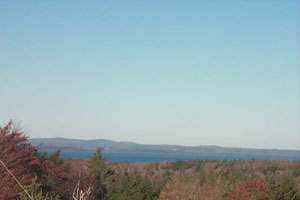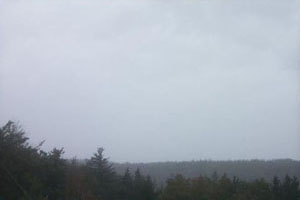Acadia Gallery of Good and Bad Days
Several examples are presented below of the types of visibility days that tend to occur in Acadia National Park. These include clear days, "hazy" polluted days, and naturally-impaired days, such as those with heavy fog or thick clouds.
For each picture, fine particle (PM2.5) concentrations and relative humidity (RH) levels are provided for reference. These variables tend to have the biggest affect on visibility. Ozone concentrations and visual range estimates are also provided. Ozone is a clear gas, but has serious health effects and is a good indicator of the overall level of manmade air pollution during the time of the photo. Visual range is estimated by instruments at the park that provide a consistent set of data, but which sometimes differ from what a human would observe. The visual range calculation is based primarily on the amount of fine particles (PM2.5) in the air and on foggy days perceived visibility may be much lower than the calculated visual range.
Click on a picture to view a larger version.
 |
Clear Day
October 29, 1999 |
 |
Clear Day
November 8, 1999
This is a typical clean, clear day in Acadia. Note the crispness of the features on the horizon. These days will have low pollution levels and low humidity.
Visual Range = 199 miles
PM2.5 = 1.4 μg/m3
Ozone = 39 ppb
RH = 39.5%
|
 |
Hazy Polluted Day
August 25, 1999
This is a typical hazy polluted day in Acadia. Note the relatively uniform white haze that obscures the horizon. The haze tends to diminish slightly at higher elevations. These events tend to occur on hot and humid summer days and are affiliated with high ozone, PM2.5, and RH levels, and winds that transport pollutants from urban and industrial areas to the southwest. Visual Range = 30 miles
PM2.5 = 17.1 μg/m3
Ozone = 104 ppb |
 |
Foggy Day
October 9, 1999 This is an example of a foggy day in Acadia. It appears similar to a hazy polluted day, but note how the fog tends to be more grey than the white haze and how it does not thin out near the top of the picture. Fog is most common in the fall and spring. RH will be very high; ozone will be low; PM2.5 may be moderate or high.
Visual Range = 29 miles
PM2.5 = 9.6 μg/m3
Ozone = 52 ppb
RH = 98% |